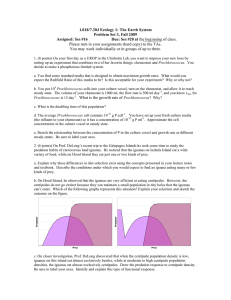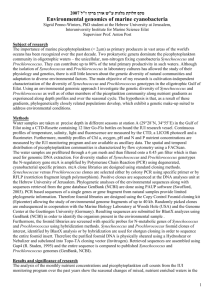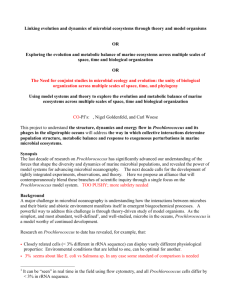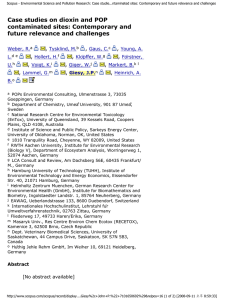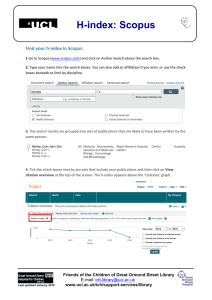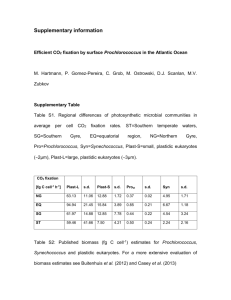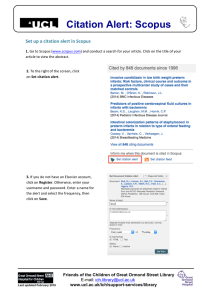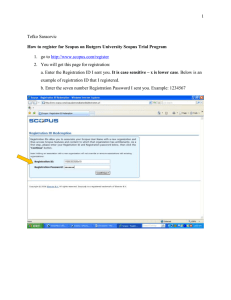Time series observation based InfraRed Epifluorescence Microscopic
advertisement
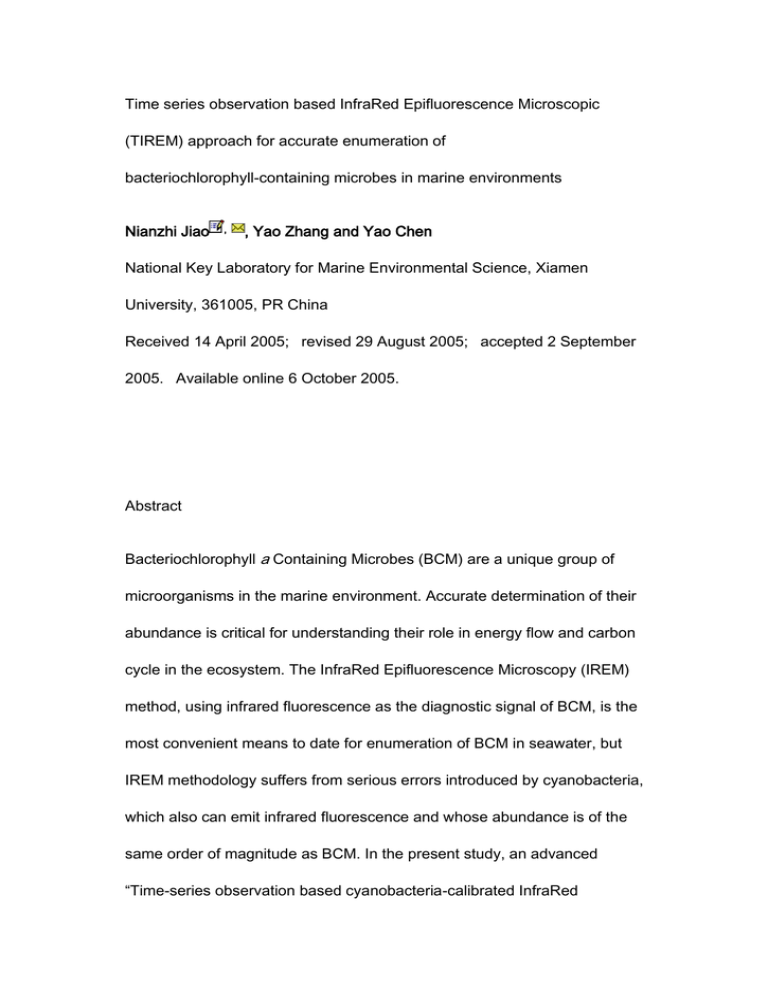
Time series observation based InfraRed Epifluorescence Microscopic (TIREM) approach for accurate enumeration of bacteriochlorophyll-containing microbes in marine environments Nianzhi Jiao , , Yao Zhang and Yao Chen National Key Laboratory for Marine Environmental Science, Xiamen University, 361005, PR China Received 14 April 2005; revised 29 August 2005; accepted 2 September 2005. Available online 6 October 2005. Abstract Bacteriochlorophyll a Containing Microbes (BCM) are a unique group of microorganisms in the marine environment. Accurate determination of their abundance is critical for understanding their role in energy flow and carbon cycle in the ecosystem. The InfraRed Epifluorescence Microscopy (IREM) method, using infrared fluorescence as the diagnostic signal of BCM, is the most convenient means to date for enumeration of BCM in seawater, but IREM methodology suffers from serious errors introduced by cyanobacteria, which also can emit infrared fluorescence and whose abundance is of the same order of magnitude as BCM. In the present study, an advanced “Time-series observation based cyanobacteria-calibrated InfraRed Epifluorescence Microscopy (TIREM)” approach is established for accurate enumeration of BCM in marine environments. The protocol is distinguished by its use of time series observation, auto-imaging and digital analysis. In principle, the correct count of BCM can be obtained by subtracting the cyanobacterial count from the total infrared positive count. The challenge, however, is that Prochlorococcus, the most abundant cyanobacterium in the sea, is readily visible in infrared images but not visible in the initial cyanobacterial images obtained by epifluorescence microscopy because its emission signals are masked by brighter fluorescence from larger cells like Synechococcus coexisting in seawater samples. Prochlorococcus cells become gradually visible when the fluorescence from Synechococcus cells declines after a period of exposure to excitation light. Therefore the plateau (maximum) count of the cyanobacterial cells in time series images rather than in the initial ones, as previously believed, represents the correct count for the total number of cyanobacteria (Synechococcus plus Prochlorococcus cells). Thus, the accurate estimation of BCM abundance can only be calculated from the formula: [BCM cells] = [plateau count of infrared positive cells] − [plateau count of cyanobacterial cells]. The conceptual advance of the TIREM protocol is that in classical epifluorescence microscopy or in IREM protocols, quick observation is recommended to avoid quenching the fluorescence, but in the TIREM protocol, instead, time series observation is the key for obtaining reliable data. The TIREM protocol is validated by studies using BCM and cyanobacterial pure cultures as well as by examination of samples from various marine environments. Keywords: Auto-photography; Bacteriochlorophyll a containing microbes; Calibration; Digitization; Infrared epifluorescence microscopy; Time series observation; Prochloroccus Article Outline 1. Introduction 2. Materials and methods 2.1. Experimental bacteria 2.2. Sample preparation 2.3. Microscopic settings 2.4. Image analysis 2.5. Efficiency and reproducibility 3. Results 3.1. Visibility of BCM and cyanobacteria under infrared epifluorescence microscopy and shading effects in cyanobacterial-images 3.2. Time series observation based BCM enumeration 3.3. The TIREM protocols 3.4. Efficiency and reproducibility of TIREM 4. Discussion Acknowledgements References 1. Introduction Bacteriochlorophyll a Containing Microbes (BCM) are a component of the microbial community in marine environments whose ecosystem role is presently unclear. A newly recognized functional group of BCM, the Aerobic Anoxygenic Phototrophic Bacteria (AAPB), has been reported to be critical in the carbon cycle of the ocean (Kolber et al., 2000 and Kolber et al., 2001). The wide distribution (Kolber et al., 2000, Kolber et al., 2001 and Schwalbach and Fuhrman, 2005) and unique function (Yurkov and Beatty, 1998, Beatty, 2002, Suyama et al., 2002 and Koblízek et al., 2003) of AAPB suggest that a better understanding of these microorganisms may change our current perspective on the energy and oxygen balance in the ocean, a view derived largely from a focus on oxygenic photosynthesis (Karl, 2002). However quantification of AAPB is difficult and different approaches have led to different conclusions regarding the importance of these microorganisms. Using InfraRed Fast Repetition Rate (IRFRR) fluorescence transient technique (Kolber et al., 2000) and InfraRed Epifluorescence Microscopy (IREM) methods, Kolber et al. (2001) estimated that AAPB could comprise 11% of the total microbial community in the ocean, and the globally average ratio of Bacteriochlorophyll a (BChl. a) to Chlorophyll a (Chl. a) could be 5% to 10%. In contrast, estimations of BChl. a / Chl. a ratio are only 0.5% to 1% by high performance liquid chromatography (HPLC) (Goericke, 2002), or 0.42% by dual modulation techniques (Koblízek et al., 2005). Although the differences among results from different researchers could be attributed partially to study location, and to ranges of the percentage contribution of AAPB to the total microbial community, i.e., from 0.01–18%, as measured by IREM and quantitative polymerase chain reaction (QPCR) (Schwalbach and Fuhrman, 2005), methodological differences likely also contribute importantly to the differences among estimates. The most convenient approach to date for enumeration of AAPB is IREM, in which infrared fluorescence from BChl. a is used as the diagnostic signal for recognition of AAPB (Kolber et al., 2001 and Schwalbach and Fuhrman, 2005). Unfortunately, the IREM protocol has been proven to involve significant errors due to the presence of cyanobacteria (Zhang and Jiao, 2004 and Schwalbach and Fuhrman, 2005). Cyanobacteria can emit infrared fluorescence when excited under the AAPB microscopic settings, and these oxygenic photosynthetic microorganisms are of the same order of magnitude in abundance as AAPB in field samples. Zhang and Jiao (2004) reported that the positive error due to Synechococcus is up to 30% in shallow waters of the East China Sea. Error introduced by another group of cyanobacteria, Prochlorococcus, has not been evaluated yet. Since Prochlorococcus is the most abundant cyanobacterium (reaching concentrations as high as 105 cells/ml) in the ocean, and the size of Prochlorococcus cells (0.4–0.8 μm) (Chisholm et al., 1988) is very similar to that of AAPB (1.0–2.5 μm in length, 0.3–1.0 μm in width) (Yurkov and Beatty, 1998), it is not possible to discriminate between these organisms using standard protocols for Epifluorescence Microscopy (EM). The presence of Prochlorococcus could introduce serious errors in enumeration of AAPB and other BCM (Zhang and Jiao, 2004 and Schwalbach and Fuhrman, 2005). In the present study, we present a “Time-series observation based cyanobacteria-calibrated InfraRed Epifluorescence Microscopy (TIREM)” approach to solve the problems caused by both Synechococcus and Prochlorococcus, and examine the protocol with BCM and cyanobacterial pure culture as well as field samples. 2. Materials and methods 2.1. Experimental bacteria Since the vast extent of surface waters of the sea is aerobic, and AAPB are the major components of BCM, two common marine AAPB genera, Erythrobacter and Roseobacter were used for the examination of the method. An Erythrobacter sp. DSM 6997 and a Roseobacter sp. DSM 6996 were purchased from the German national resource center for biological material (DSMZ), Braunschweig, Germany. For cyanobacteria, the common genera in marine environments are Synechococcus and Prochlorococcus (Partensky et al., 1999). For Synechococcus, a phycoerythrin (PE) strain, the CCMP 840 and a phycocyanin (PC) strain, the CCMP 1630 were tested, the former is dominant in oceanic water and the later is mainly present in coastal water (Urbach et al., 1998, Honda et al., 1999 and Toledo et al., 1999). For Prochlorococcus, a low-light adapted ecotype strain, the CCMP 1375 (Hess et al., 1999), and a high-light adapted strain, the CCMP 1986 (Steglich et al., 2003), were examined in this study. All the cyanobacterial strains were purchased from the Provasoli-Guillard National Center for Culture of Marine Phytoplankton (CCMP), Maine, USA. 2.2. Sample preparation Culture samples were diluted and stained with 5 μg/ml 4′,6-diamidino-2-phenylindole (DAPI) for 30 min in the dark, and then the cells were collected by filtration through 0.2 μm-pore-size black polycarbonate (PC) membranes (Whatman) for microscopic observation. Field samples were collected with Niskin bottles mounted on a CTD deployed in near surface estuarine, continental shelf, and oceanic waters of the East and South China Seas. Aliquots of 20 ml seawater were immediately fixed for 15 min with 2% paraformaldehyde (PFA) after sampling, and then stained with DAPI for 30 min in the dark. Cells were filtered onto 0.2 μm-pore-size black PC membranes (Whatman) for abundance determination. 2.3. Microscopic settings Cells with infrared fluorescence were viewed with an infrared-sensitive charge-coupled device (CCD) camera (SPOT Diagnostic Instruments, Inc.) on an epifluorescence microscope with a 50-W mercury lamp (Carl Zeiss Light Microscopy AXIOSKOP 40) using the following filter set (Chroma Technology Corp): excitation 350 to 550 nm, emission LP 850 nm, beam splitter 650 nm (Kolber et al., 2001 and Zhang and Jiao, 2004) (IR-settings). DAPI-stained cells were used as reference and were viewed at excitation 330 to 390 nm, emission 440 to 490 nm, beam splitter 400 to 430 nm (Zeiss Filter set 02) (Kolber et al., 2001 and Zhang and Jiao, 2004) (DAPI-settings). Cyanobacterial cells were viewed at excitation BP 546 ± 12 nm, emission LP 590 nm (Li and Wood, 1988 and Sherry and Wood, 2001), beam splitter FT 580 nm (Zeiss Filter set 15) (Cyano-settings). DAPI-stained images (DAPI-image), cyanobacterial images (Cyano-image) and infrared images (IR-images) were acquired for each microscopic view field using a 100× oil immersion objective. All images were captured using automatic exposure with a gain limit of 8. Time series images of DAPI-, Cyano-and IR-images were obtained for 10–15 min at intervals of 60 s from the start of the exposure (after a focusing process of about 30 s). 2.4. Image analysis Signals (cells) in the images were detected and analyzed using Image-Pro Plus (IPP) software (Media Cybernetics, Inc.). In the first step, the mean background gray value of an image was determined, and then the image was standardized by remapping the image gray values to the total standardized gray value range based on the mean value. In the second step, a “variance” filter (standard deviation for the 3 × 3 neighborhood of each pixel) was applied to the image treatment to enhance contrast with the background. In the third step, the output image was smoothed with a median filter by modifying pixels that varied significantly from their surroundings. This was accomplished by replacing the center pixel in a 3 × 3 neighborhood with the median value of the neighborhood. Although median filtering softens an image, it generally preserves its edges. This filter is particularly effective at removing random, high-impulse noise from an image. After that, the binary images representing cell objects were produced by segmenting images at a fixed gray value. In the binary images, each signal spot represented “1” regardless of size, and background represented “0”. Finally Spot-to-spot localization based Boolean AND operation was applied to the DAPI-, Cyano- and IR-binary images for the determination of BCM counts. 2.5. Efficiency and reproducibility The efficiency and reproducibility of the TIREM method was examined using triplicate comparison between the TIREM protocol and normal DAPI epifluorescence protocol with the above stated AAPB and cyanobacterial strains. Statistical analysis was applied to test for differences between the results of the different protocols. 3. Results 3.1. Visibility of BCM and cyanobacteria under infrared epifluorescence microscopy and shading effects in cyanobacterial-images IREM examination of the pure cultures of Erythrobacter sp. DSM 6997, Roseobacter sp. DSM 6996, Synechococcus sp. CCMP 840 (PE strain) and CCMP 1630 (PC strain), and Prochlorococcus sp. CCMP 1375 (low-light adapting ecotype) and CCMP 1986 (high-light adapting ecotype) showed that each of the strains is visible under the IREM condition set for BCM detection (data not shown). The corresponding DAPI stained images demonstrated that all of the cyanobacterial cells were adequately shown on both IR-images and the Cyano-images. That is, the presence of both Synechococcus and Prochlorococcus in BCM samples could result in positive errors in BCM enumeration and Cyano-counts need to be subtracted from the IR-counts to avoid such errors. However, such subtraction has to be done very carefully in natural water samples when all of the microorganisms are present: we found serious shading effects of Synechococcus cells on Prochlorococcus cells in the Cyano-images from the mixed culture samples. Examination of various combination of Prochlorococcus sp. CCMP 1375, 1986 and Synechococcus sp. CCMP 1630, 840 under the Cyano-settings and DAPI settings showed that neither the Prochlorococcus low-light ecotype strain nor the Prochlorococcus high-light ecotype strain were visible in the Cyano-images at the beginning of the observation in the presence of Synechococcus. In contrast, Prochlorococcus cells gradually became visible in the later Cyano-images of a time series observation, as the fluorescence of Synechococcus gradually decayed with increasing exposure time. Using the DAPI counts as a reference, it can be easily seen that the plateau (maximum) value of the Cyano-positives, rather than the initial value, as previously believed, represented the correct number of cyanobacteria in the sample (Fig. 1). Such shading effects were also found in the Cyano-images of mixtures of the BCM, the Synechococcus and the Prochlorococcus strains. In the mixture of Erythrobacter sp. DSM 6997 + Synechococcus sp. CCMP 840 + Prochlorococcus sp. CCMP 1375 (Fig. 2), DAPI positives (Fig. 2a) equaled the IR positives (Fig. 2b) confirming the visibility of all the microbes under IR settings. However, in the Cyano-images, Prochlorococcus cells were invisible at the beginning (Fig. 2c) but became visible from the 3rd Cyano-image onward (Fig. 2d). Therefore, a time series observation of Cyano-positives is necessary to eliminate the shading effects. Display Full Size version of this image (14K) Fig. 1. Time course of the Cyano-counts and DAPI counts of the mixture of Prochlorococcus sp. CCMP 1375 and Synechococcus sp. CCMP 840, showing the shading effects of Synechococcus cells on Prochlorococcus cells at the beginning of exposure. Display Full Size version of this image (69K) Fig. 2. Time series observation of mixture of Erythrobacter sp. DSM 6997 + Synechococcus sp. CCMP 840 + Prochlorococcus sp. CCMP 1375. a. DAPI-image; b. Initial IR-image; c. Initial Cyano-image; d. Cyano-image of 3.5 min exposure. 3.2. Time series observation based BCM enumeration In the time series observations of all the combinations of Erythrobacter sp. DSM 6997, 6996, Synechococcus sp. CCMP 840, 1630 and Prochlorococcus sp. CCMP 1375, 1986, both the IR-positives and Cyano-positives showed plateau values (Fig. 3). The plateau values in the IR-images showed up at the beginning, as usually expected, but the plateau values in the Cyano-images were not evident until a few minutes after the exposure began (Fig. 3). Therefore accurate estimation of BCM abundance would be calculated from the formula: [BCM cells] = [plateau count of IR-positives] − [plateau count of Cyano-positives], and these procedures can be called “Time series observation based cyanobacteria-calibrated InfraRed Epifluorescence Microscopic enumeration of BCM” (TIREM). Display Full Size version of this image (96K) Fig. 3. Time course of IR counts (round), Cyano-counts (triangle), and DAPI counts (square) of the mixture of BCM cells and cyanobacterial cells, showing the shading effects of Synechococcus cells on Prochlorococcus cells and the plateau values of Cyano-counts. a. Erythrobacter sp. DSM 6997 + Synechococcus sp. CCMP 840 + Prochlorococcus sp. CCMP 1375; b. Erythrobacter sp. DSM 6997 + Synechococcus sp. CCMP 840 + Prochlorococcus sp. CCMP 1986; c. Roseobacter sp. DSM 6996 + Synechococcus sp. CCMP 840 + Prochlorococcus sp. CCMP 1375; d. Roseobacter sp. DSM 6996 + Synechococcus sp. CCMP 840 + Prochlorococcus sp. CCMP 1986; e. Erythrobacter sp. DSM 6997 + Synechococcus sp. CCMP 1630 + Prochlorococcus sp. CCMP 1375; f. Erythrobacter sp. DSM 6997 + Synechococcus sp. CCMP 1630 + Prochlorococcus sp. CCMP 1986; g. Roseobacter sp. DSM 6996 + Synechococcus sp. CCMP 1630 + Prochlorococcus sp. CCMP 1375; h. Roseobacter sp. DSM 6996 + Synechococcus sp. CCMP 1630 + Prochlorococcus sp. CCMP 1986. The TIREM approach was validated in field studies using a variety of seawater samples from estuarine, the continental shelf, and oceanic waters in the East and South China Seas. An example from the South China Sea is shown in Fig. 4. The corresponding observation time course showed that the maximum IR-counts and Cyano-counts appeared in the first four IR-images and in the 3rd through 8th Cyano-images, respectively, while the DAPI-counts remained nearly the same during the whole time course (Fig. 3 and Fig. 5). Display Full Size version of this image (86K) Fig. 4. Time series observation of a seawater sample from the South China Sea (115.24E, 20.75N). a. Initial DAPI-image; b. Initial IR-image; c. Initial Cyano-image; d. The 3rd Cyano-image. Display Full Size version of this image (20K) Fig. 5. Time course of DAPI counts (square), IR counts (round) and Cyano-counts (triangle) of the seawater sample form the South China Sea. 3.3. The TIREM protocols Taking the field sample (Fig. 4) as an example, we recommend, processing the images according to the following steps and calculating the number of BCM in the microscopic view field using the following protocol: Step 1 Obtain an IR-image to determine the total number of IR positives (Fig. 6a), and the corresponding IPP output (binary digitization of the spots) of the IR images (Fig. 6b). Display Full Size version of this image (182K) Fig. 6. Images process of the TIREM outputs of the field sample. a. IR-image for total IR positives; b. The corresponding IPP output (binary digitization of the spots) of a; c. The 3rd Cyano-image for total cyanobacterial positives; d. The corresponding IPP output of c; e. DAPI-image for total microbial positives; f. The corresponding IPP output of e; g. The output of Boolean AND [(b), (f)] for IR cell counts; h. Output of Boolean AND [(b), (d)] for cyanobacterial cell counts. Step 2 Obtain a Cyano-image for total Cyano-positives (Fig. 6c), and determine the corresponding IPP output of the total Cyano-positives (Fig. 6d). Step 3 Obtain the DAPI-image for total microbial positives (Fig. 6e), and the corresponding IPP output of the DAPI-image for the following Boolean AND operations (Fig. 6f). Step 4 Obtain the output of Boolean AND [(b), (f)] for IR cell counts (Fig. 6g) and the output of Boolean AND [(b), (d)] for cyanobacterial cell counts (Fig. 6h). Step 5 Calculate BCM counts in the view field: [BCM counts] = [count of (g)] − [count of (h)]. 3.4. Efficiency and reproducibility of TIREM The efficiency and reproducibility of the TIREM protocol was confirmed by triplicate examinations of AAPB and cyanobacterial counts under TIREM settings with reference to DAPI counts (Table 1). The low standard division (SD, and thus low coefficients of variation, CV) as well as the good consistency between outputs of TIREM and DAPI indicated that TIREM could yield reliable data. Table 1. Efficiency and reproducibility of TIREM method Samplesa BCM concentration (105 cells/ml)b Cyanobacterial concentration (105 cells/ml)b TIREM based DAPI based TIREM based DAPI based (mean ± SD) (mean ± SD) (mean ± SD) (mean ± SD) a 1.31 (± 0.09) 1.29 (± 0.07) 5.86 (± 0.20) 5.99 (± 0.22) b 1.30 (± 0.09) 1.29 (± 0.07) 2.72 (± 0.09) 2.74 (± 0.08) c 3.81 (± 0.12) 3.83 (± 0.15) 5.92 (± 0.23) 5.99 (± 0.22) d 3.78 (± 0.10) 3.83 (± 0.15) 2.70 (± 0.09) 2.74 (± 0.08) e 1.28 (± 0.07) 1.29 (± 0.07) 1.66 (± 0.04) 1.63 (± 0.04) f 1.32 (± 0.09) 1.29 (± 0.07) 4.74 (± 0.11) 4.70 (± 0.13) g 3.81 (± 0.13) 3.83 (± 0.15) 1.62 (± 0.03) 1.63 (± 0.04) Samplesa BCM concentration (105 cells/ml)b Cyanobacterial concentration (105 cells/ml)b TIREM h based DAPI based TIREM based DAPI based (mean ± SD) (mean ± SD) (mean ± SD) (mean ± SD) 3.79 (± 0.10) 3.83 (± 0.15) 4.71 (± 0.10) 4.70 (± 0.13) a Samples a, b, c, d, e, f, g and h here are the same as in Fig. 3. b Note that the units in the table are different from Fig. 3. 4. Discussion Theoretically, all autotrophic microbes that contain bacterial chlorophyll a (BCM) could be enumerated by IREM as they can emit some infrared fluorescence when excited by appropriate wavelengths. In field samples of seawater, however, cyanobacteria are usually abundant enough to cause significant errors in BCM enumeration using such an approach. Other photoautotrophs are either too few in abundance or too large in cell size to interfere in BCM microscopic observations. In this study, the authors focused on the principal, naturally occurring microorganisms that cause such interference, namely cyanobacteria, and present a solution for removing potential errors from co-occurring Prochlorococcus, which is very abundant in the ocean and could greatly interfere with the enumeration of BCM. The proposed TIREM method, which uses infrared epifluorescence microscopy, CCD camera autophotography and image digitization, provides accurate counts of infrared-positive cells and cyanobacteria in the same microscopic field of view. For epifluorescence protocols in a given application, the suitability of normal settings — especially the excitation wavelengths and their strengths — should be examined if the target cells are very small or cellular pigment content is low. In this study, Prochlorococcus is used as an example. Theoretically the optimum excitation wavelengths for Prochlorococcus would be 450–480 nm (Chisholm et al., 1988 and Partensky et al., 1997); however, Prochlorococcus has been reported to be extremely difficult to enumerate microscopically under these excitation lights (Schwalbach and Fuhrman, 2005). Our examination showed that excitation at 450–480 nm would make Prochlorococcus cells quench too fast for the system to obtain reliable data. In contrast, the optimum excitation wavelength for Synechococcus, 546 ± 12 nm, was proved to be good for Prochlorococcus as well. Microscopic enumeration of Prochlorococcus sp. CCMP 1375 excited by 450–480 nm and by 546 ± 12 nm yielded the same cell counts initially, but Prochlorococcus cells faded very rapidly under 450–480 nm excitation, resulting in potential negative errors when counts are not made sufficiently quickly. In contrast, Prochlorococcus cells excited at 546 ± 12 nm were visible for a much longer time, making the data acquisition easier. Therefore 546 ± 12 nm was used in this study. This way, both Synechococcus and Prochlorococcus were excited under the same conditions at the same time. When both Synechococcus and Prochlorococcus are present simultaneously in the sample, time series acquisition of cyanobacterial images is necessary because the two major cyanobacterial groups emit fluorescence at different levels. Prochlorococcus are not really visible at the initial Cyano-images by autophotography of the CCD camera because their signals are masked by brighter fluorescence from the larger cells of Synechococcus. In the CCD processing of the images, only signals above a certain level were recognized and the imaging depends on the relative intensities of signals from different source in a micro-field. Photons emitted from particles with strong fluorescence are much more numerous than those from particles with weak fluorescence. Most photons acquired by CCD are from particles with strong fluorescence during the exposure. Therefore, particles with strong fluorescence can be seen clearly in the digital images, while particles with weak fluorescence could not be distinguished from background, “noise”. Prochlorococcus cells become gradually visible when the fluorescence from the brighter Synechococcus cells decays somewhat after exposure to excitation light. Although absolute fluorescence intensities from Synechococcus and Prochlorococcus both declined with exposure time, the bright cells dim more quickly than the more weakly fluorescing cells, according to principals of fluorescence decay kinetics (Kless and Vermaas, 1995 and Byrdin et al., 2000). The relative optical densities (OD) of Synechococcus and Prochlorococcus in the TIREM Cyano-images became closer with exposure time (Fig. 7) and thus allowed an opportunity for both of them to be viewed by the CCD camera. Display Full Size version of this image (21K) Fig. 7. Time course of the optical density (OD) of the fluorescence of Synechococcus sp. CCMP 840 and Prochlorococcus sp. CCMP1375 and background in the CCD Cyano-images. In classical Epifloursecense Microscopy or IREM protocols, rapid initial observation is required to avoid quenching the fluorescence and thus reducing the negative errors. This perspective is flawed in the situation described in the present study, and instead time series observations are actually key to obtaining reliable data. The results presented here represent a conceptual change in the traditional approach to epifluorescence microscopy protocols. In addition, digitization of the image is an important procedure that helps remove light “noise” and renders the data more repeatable and useful for comparisons. We emphasize, however, that the subtractions for IR-positives and Cyano-positives require a spot-to-spot based operation. That is, the subtraction can only be conducted between corresponding spots appearing on both the IR- and Cyano-images. Such a practice will avoid any non-cell cross-talk (i.e., feedbacks). In practice, the TIREM protocol is not only good for BCM enumeration, but also provides an approach for Prochlorococcus enumeration. Since Prochlorococcus cells are very small, and fluorescence is very dim and quenches very quickly under the normal illumination used for epifluorsecense microscopy (such as excitation light of 450–480 nm), it was not practically countable under epifluorsecense microscopy (Sieracki et al., 1995, Partensky et al., 1999 and Schwalbach and Fuhrman, 2005). On the other hand, if the cells are dyed with DNA stains (such as DAPI, SYBR Green I), all the microbes in seawater samples including heterotrophic bacteria and Prochlorococcus are labeled and thus cannot be distinguished from one another. Therefore, classical epifluorsecense microscopy is usually not recommended for Prochlorococcus counting but flow cytometry instead, has been considered to be the most satisfactory approach to count Prochlorococcus at the present time (Sieracki et al., 1995 and Jiao et al., 2001). Now, using the time series observation protocol that we describe in the present study, one can count Prochlorococcus — or at least the sum of Synechococcus and Prochlorococcus — without staining the cells. Meanwhile the concerns of positive errors introduced by Prochlorococcus in total bacterial counts by epifluorsecense microscopy (Sieracki et al., 1995 and Jiao et al., 2001) can be solved by subtracting the cyanobacterial counts from the total counts of the stained positives: thus both the autotrophs and heterotrophs can be counted using a single epifluorescence approach. There are some other techniques for measuring BCM abundance, such as the IRFRR (Kolber et al., 2000 and Kolber et al., 2001), and HPLC (Goericke, 2002), QPCR (Schwalbach and Fuhrman, 2005) techniques. IRFRR is a unique technique and is capable of measuring bacterial photosynthetic electron transport (Kolber et al., 2000), but is a “state of the art” technique only available in relatively few laboratories. IRFRR also suffers from interference from pigments other than BChl.a. HPLC provides direct measurements of BChl. a / Chl. a, and is good for distinguishing between BCM and phytoplankton in terms of photosynthetic pigments, but it is not appropriate for biomass assessments. The QPCR approach is based on molecular probes and thus BChl. a independent, which is a promising approach and would be good for groups of BCM that share the same gene sequence. The limitation of this method, however, is that BCM organisms are not well studied and there are not enough known sequences for the design of primers that would include all the BCM. These alternative techniques, however, cannot yield direct estimates of the abundance of BCM. Compared with these currently available methods for BCM measurements, the TIREM protocol is relatively easy to operate and cheap in cost, and is also capable of distinguishing BCM and cyanobacteria from other photoautotrophs in the sample. In addition, epifluorescence microscopes are available in ordinary laboratories, and thus TIREM is the most convenient means to date for BCM enumeration, if the users have access to a suitable light source, epifluorescence microscope with appropriate filter sets, an infrared sensitive camera and digitizing software. Applications of the TIREM protocol to field samples from estuarine, continental shelf, and oceanic waters in the East and South China Seas showed that great errors could have been introduced in the previous IREM protocol (Table 2), especially for the oceanic water where Prochlorococcus is very abundant (104–105 cells/ml), and that BCM would have been overestimated by a factor of 10. Therefore, we recommend the use of TIREM protocols to accurately enumerate BCM in marine environments. Table 2. Errors introduced by cyanobacteria in different marine environments Estuarine Shelf Oceanic IR positive (cells/ml) (3.5–8.0) × 104 (3.1–19) × 104 (2.2–20) × 104 BCM (cells/ml) (3.2–6.6) × 104 (1.1–3.8) × 104 (0.1–1.1) × 104 Cyanobacteria (cells/ml) (0.4–3.0) × 104 (1.1–17) × 104 (1.2–20) × 104 Approximate error range Estuarine Shelf Oceanic 10–60% 30 500% 200 10,000% Acknowledgements This work was supported by the National Natural Science Foundation of China project. No. 40232021, and the Ministry of Science and Technology Projects: 2005AA635240; G2000785004, 2003DF000040 and 2001CB 409700. We thank Rulong Liu, Qiang Li for their assistance in sampling and in the preparation of materials. We are grateful to Dr Mary Silver from University of California for her assistance in revising the manuscript. References Beatty, 2002 J.T. Beatty, On the natural selection and evolution of the aerobic phototrophic bacteria, Photosynth. Res. 73 (2002), pp. 109–114. Full Text via CrossRef | Abstract + References in Scopus | Cited By in Scopus Byrdin et al., 2000 M. Byrdin, I. Rimke, E. Schlodder, D. Stehlik and T.A. Roelofs, Decay kinetics and quantum yields of fluorescence in photosystem I from Synechococcus elongatus with P700 in the reduced and oxidized state: are the kinetics of excited state decay trap-limited or transfer-limited?, Biophys. J. 79 (2000), pp. 992–1007. Abstract + References in Scopus | Cited By in Scopus Chisholm et al., 1988 S.W. Chisholm, R.J. Olson, E.R. Zettler, R. Goericke, J.B. Waterbury and N.A. Welschmeyer, A novel free-living prochlorophyte abundant in the oceanic euphotic zone, Nature 334 (1988), pp. 340–343. Full Text via CrossRef | Abstract + References in Scopus | Cited By in Scopus Goericke, 2002 R. Goericke, Bacteriochlorophyll a in the ocean: is anoxygenic bacterial photosynthesis important?, Limnol. Oceanogr. 47 (2002), pp. 290–295. Abstract + References in Scopus | Cited By in Scopus Hess et al., 1999 W.R. Hess, C. Steglich, C. Lichtle and F. Partensky, Phycoerythrins of the xyphotobacterium Prochlorococcus marinus are associated to the thylakoid membrane and are encoded by a single large gene cluster, Plant Mol. Biol. 40 (1999), pp. 507–521. Full Text via CrossRef | Abstract + References in Scopus | Cited By in Scopus Honda et al., 1999 D. Honda, A. Yokota and J. Sugiyama, Detection of seven major evolutionary lineages in cyanobacteria based on the 16S rRNA gene sequences analysis with new sequences of five marine Synechococcus strains, J. Mol. Evol. 48 (1999), pp. 723–739. Full Text via CrossRef | Abstract + References in Scopus | Cited By in Scopus Jiao et al., 2001 N.Z. Jiao, Y.H. Yang, H. Koshikawa, S. Harada and M. Watanabe, Microscopic overestimation of heterotrophic bacteria in open waters of China Seas, J. Microbiol. Biotechnol. 11 (2001), pp. 889–901. Karl, 2002 D.M. Karl, Hidden in a sea of microbes, Nature 415 (2002), pp. 590–591. Full Text via CrossRef | Abstract + References in Scopus | Cited By in Scopus Kless and Vermaas, 1995 H. Kless and W. Vermaas, Many combinations of amino acid sequences in a conserved region of the d1 protein satisfy photosystem ii function, J. Mol. Biol. 246 (1995), pp. 120–131. Abstract | PDF (325 K) | Abstract + References in Scopus | Cited By in Scopus Koblízek et al., 2003 M. Koblízek, O. Béjà, R.R. Bidigare, S. Christensen, B. Benetiz-Nelson, C. Vetriani, M.K. Kolber, P.G. Falkowski and Z.S. Kolber, Isolation and characterization of Erythrobacter sp. strains from the upper ocean, Arch. Microbiol. 180 (2003), pp. 327–338. Full Text via CrossRef | Abstract + References in Scopus | Cited By in Scopus Koblízek et al., 2005 M. Koblízek, J. Stoń-Egiert, S. Sagan and Z. Kolber, Diel changes in bacteriochlorophyll a concentration suggest rapid bacterioplankton cycling in the Baltic Sea, FEMS Microbiol. Ecol. 51 (2005), pp. 353–361. Abstract + References in Scopus | Cited By in Scopus Kolber et al., 2000 Z.S. Kolber, C.L. Van Dover, R.A. Niederman and P.G. Falkowski, Bacterial photosynthesis in surface waters of the open ocean, Nature 407 (2000), pp. 177–179. Abstract + References in Scopus | Cited By in Scopus Kolber et al., 2001 Z.S. Kolber, F.G. Plumley, A.S. Lang, J.T. Beatty, R.E. Blankenship, C.L. VanDover, C. Vetriani, M. Koblízek, C. Rathgeber and P.G. Falkowski1, Contribution of aerobic photoheterotrophic bacteria to the carbon cycle in the ocean, Science 292 (2001), pp. 2492–2495. Full Text via CrossRef | Abstract + References in Scopus | Cited By in Scopus Li and Wood, 1988 W.K.W. Li and A.M. Wood, Vertical distribution of North Atlantic ultraphytoplankton: analysis by flow cytometry and epifluorescence microscopy, Deep-Sea Res 35 (1988), pp. 1615–1638. Partensky et al., 1997 F. Partensky, J. La Roche, K. Wyman and P.G. Falkowski, The divinyl-chlorophyll a/b-protein complexes of two strains of the oxyphototrophic marine prokaryote Prochlorococcus — characterization and response to changes in growth irradiance, Photosynth. Res. 51 (1997), pp. 209–222. Full Text via CrossRef | Abstract + References in Scopus | Cited By in Scopus Partensky et al., 1999 F. Partensky, W.R. Hess and D. Vaulot, Prochlorococcus, a marine photosynthetic prokaryote of global significance, Microbiol. Mol. Biol. Rev. 63 (1999), pp. 106–127. Abstract + References in Scopus | Cited By in Scopus Schwalbach and Fuhrman, 2005 M.S. Schwalbach and J.A. Fuhrman, Wide-ranging abundances of aerobic anoxygenic phototrophic bacteria in the world ocean revealed by epifluorescence microscopy and quantitative PCR, Limnol. Oceanogr. 50 (2005), pp. 620–626. Sherry and Wood, 2001 N.D. Sherry and A.M. Wood, Phycoerythrin-containing picocyanobacteria in the Arabian Sea in February 1995: diel patterns, spatial variability, and growth rates, Deep-Sea Res., Part 2, Top. Stud. Oceanogr. 48 (2001), pp. 1263–1283. SummaryPlus | Full Text + Links | PDF (482 K) | Abstract + References in Scopus | Cited By in Scopus Sieracki et al., 1995 M.E. Sieracki, E.M. Haugen and T.L. Cucci, Overestimation of heterotrophic bacteria in the Sargasso Sea: direct evidence by flow and imaging cytometry, Deep-Sea Res., Part 2, Top. Stud. Oceanogr. 42 (1995), pp. 1399–1409. SummaryPlus | Full Text + Links | PDF (786 K) | Abstract + References in Scopus | Cited By in Scopus Steglich et al., 2003 C. Steglich, A.F. Post and W.R. Hess, Analysis of natural populations of Prochlorococcus spp. in the northern Red Sea using phycoerythrin gene sequences, Environ. Microbiol. 5 (2003), pp. 681–690. Full Text via CrossRef | Abstract + References in Scopus | Cited By in Scopus Suyama et al., 2002 T. Suyama, T. Shigematsu, T. Suzuki, Y. Tokiwa, T. Kanagawa, K.V.P. Nagashima and S. Hanada, Photosynthetic apparatus in Roseateles depolymerans 61A is transcriptionally induced by carbon limitation, Appl. Environ. Microbiol. 68 (2002), pp. 1665–1673. Full Text via CrossRef | Abstract + References in Scopus | Cited By in Scopus Toledo et al., 1999 G. Toledo, B. Palenik and B. Brahamsha, Swimming marine Synechococcus strains with widely different photosynthetic pigment ratios from a monophyletic group, Appl. Environ. Microbiol. 65 (1999), pp. 5247–5251. Abstract + References in Scopus | Cited By in Scopus Urbach et al., 1998 E. Urbach, D.J. Scanlan, D.L. Distel, J.B. Waterbury and S.W. Chisholm, Rapid diversification of marine picophytoplankton with dissimilar light-harvesting structures inferred from sequences of Prochlorococcus and Synechococcus (cyanobacteria), J. Mol. Evol. 46 (1998), pp. 188–201. Full Text via CrossRef | Abstract + References in Scopus | Cited By in Scopus Yurkov and Beatty, 1998 V.V. Yurkov and J.T. Beatty, Aerobic anoxygenic phototrophic bacteria, Microbiol. Mol. Biol. Rev. 62 (1998), pp. 695–724. Abstract + References in Scopus | Cited By in Scopus Zhang and Jiao, 2004 Y. Zhang and N.Z. Jiao, Method for quantification of aerobic anoxygenic phototrophic bacteria, Chin. Sci. Bull. 49 (2004), pp. 597–599. Full Text via CrossRef | Abstract + References in Scopus | Cited By in Scopus
